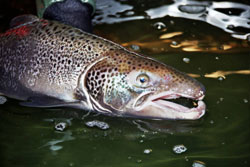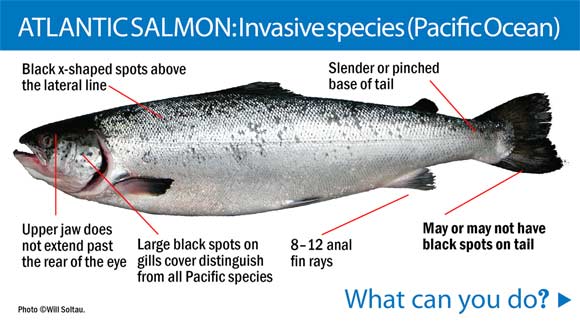Invasive Species — Atlantic Salmon (Salmo salar)
Biological Characteristics
Identification
 Atlantic salmon have large black spots on their gill covers and may or may not have spots on their tail fins.
Although frequently lacking spots on the tail, all of specimens turned in to the Department of Fish and Game
in 2009 had tail spots. Atlantic salmon also may have fewer anal fins rays (8–12) than Pacific salmon
(11–13).
Atlantic salmon have large black spots on their gill covers and may or may not have spots on their tail fins.
Although frequently lacking spots on the tail, all of specimens turned in to the Department of Fish and Game
in 2009 had tail spots. Atlantic salmon also may have fewer anal fins rays (8–12) than Pacific salmon
(11–13).

Biology
Atlantic salmon are anadromous. This means that they typically live in freshwater for the first 2–3 years of life before migrating to the sea where they live another 1-2 years before returning to freshwater to reproduce. Like Pacific salmon, Atlantic salmon generally return to their natal streams for spawning. Spawning occurs in October and November, and the eggs usually hatch in April. The young remain in the gravel as alevin until the yolk sac is absorbed and they emerge as fry in May or June. Young Atlantic salmon feed on aquatic insects until they develop into smolt and migrate to the sea. As adults in the ocean, Atlantic salmon will feed on fish such as herring, smelt, and small mackerel before returning to freshwater for spawning. Unlike Pacific salmon, Atlantic salmon are capable of spawning more than once during their life time. However, most Atlantic salmon do not survive past their first spawn.
